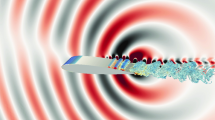Abstract:
In Part II a large-scale sound source in a time-developing planar free mixing layer is studied using an acoustic analogy approach. It is shown that only the non-compact character of the source resembles well the character of the corresponding source in a spatially developing flow. A model based on a continuous assembly of wave packets is derived and applied to direct numerical simulation results of two supersonic time-developing mixing layers undergoing transition to turbulence. The analysis predicts two distinctive dominant Mach wave sources in agreement with the direct analysis of Part~I. The first dominates during the stage of the Λ-vortex structure and the second just prior to the final breakdown to a fine-scale structure. The convective velocity of the second Mach wave source is higher than the first and thus its Mach angle of radiation is higher. The second source has a reduced strength at the higher free-stream Mach number. Directivity and frequency spectra compare well with the results of Part I, demonstrating that the assumptions inherent in the analogy are quite reasonable.
Similar content being viewed by others
Author information
Authors and Affiliations
Additional information
Received 5 August 1997 and accepted 6 April 1998
Rights and permissions
About this article
Cite this article
Avital, E., Sandham, N. & Luo, K. Mach Wave Radiation by Mixing Layers. Part II: Analysis of the Source Field . Theoret. Comput. Fluid Dynamics 12, 91–108 (1998). https://doi.org/10.1007/s001620050101
Issue Date:
DOI: https://doi.org/10.1007/s001620050101




